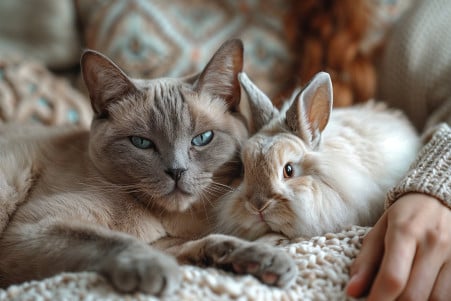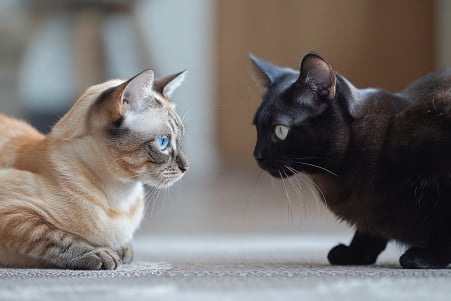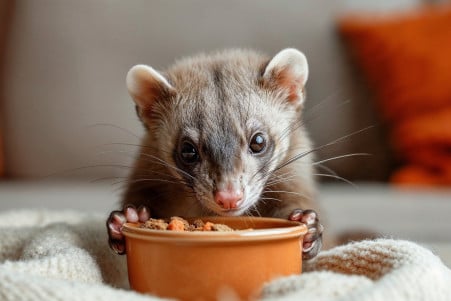Can Cats and Ferrets Live Together? What Science Says
12 March 2024 • Updated 11 March 2024

Cats are known for their grace, while ferrets are known for their mischief, but can these two very different animals coexist peacefully? The good news is that cats and ferrets can live together and even become friends, but whether or not they will depends on their individual personalities and how they are introduced to one another.
That said, it’s important to keep a close eye on them to make sure they are getting along and to make sure the cat doesn’t exhibit predatory behavior, especially at first.
This article will review the latest research in animal behavior, animal psychology, and veterinary science to explain how cats and ferrets interact when they live together. By looking at their natural instincts and social behaviors, you’ll learn how these things affect their interactions.
The article will also cover best practices recommended by experts to help ensure that your pets live together in peace. This will give you the information you need to make sure your furry friends get along.
Can cats and ferrets live together?
Cat and Ferret Behavior
Cats are descended from solitary hunters, and their hunting behavior is still largely solitary. Yet, as International Cat Care explains, domestic cats are highly adaptable and can form social groups similar to prides when resources are abundant. Ferrets, on the other hand, are naturally social animals, a trait that’s been further enhanced by domestication, according to Exotic Pet Behavior, which has made them even more likely to seek out the company of others.
The solitary cat and the social ferret are an interesting contrast. Cats may be able to adapt to living with others, but they still retain many of the traits of their ancestors, including their territorial nature and their tendency to hunt alone.
This is reflected in their behavior, which includes scent marking to communicate with other cats and avoid conflict. Meanwhile, ferrets’ social nature means they are often more accepting of interaction, and as a result, their domestication has made them less territorial than their wild ancestors.
This is important for pet owners to know so they can ensure a successful introduction. Knowing that cats need their space and that ferrets are likely to want to interact can help pet owners manage their first meetings. In time, however, and with the right care, cats and ferrets can form a special relationship, using their adaptability to form a bond that crosses species lines.
Understanding Play and Hunt: The Cat-Ferret Relationship
A paper published in PubMed by M.J. Baum explains that hormonal influences in ferrets lead to play behavior, which includes a combination of chasing, nipping, and rough-and-tumble play. Although ferrets mean these behaviors to be social, cats, who have strong hunting instincts, may see them differently.
A paper in PMC by Dave J. Hodgson explains that cats, who are skilled hunters, often hunt alone and may see the ferrets’ play as prey behavior, which can lead to a predatory reaction.
It’s important to understand these natural behaviors in order to live together successfully.
Owners need to understand that a cat’s natural pounce and a ferret’s natural play can lead to a lack of understanding between the two species.
To encourage a positive relationship, it’s important to make sure that play is supervised and to understand the meaning behind each behavior. This can include redirecting a cat’s hunting behavior with the right toys and making sure that ferrets have plenty of opportunities to play with other ferrets. This can help keep these natural behaviors in check.
Understanding and managing these behaviors is important not just for their relationship but also for setting them up for a successful life together.
Managing Territory and Communication in Multi-Species Households
Cats are well-known for their territorial nature, which they often express through urine marking—a topic that has been thoroughly researched and documented in PubMed by M.J. Bain. Cats mark their territory with their scent as a way to communicate without being confrontational and to help them establish social hierarchies.
However, this can lead to miscommunications and stress in a multi-species household with ferrets, who also have territorial tendencies, according to Small Mammal Research, because of their natural instincts.
Ferrets’ territorial tendencies can be impacted by the size of their enclosures, which can affect the relationship between these two species and their feline housemates. Pet parents can help to control the environment to minimize the potential for territorial issues. This can be done by creating a situation where each animal has their own space and by cleaning marked areas to remove the scent, according to research in PubMed.
Another way to help reduce the likelihood of stress-induced marking is to enrich the environment with hiding spaces and separate resources. By creating a structured environment that allows for each animal to have their own space, pet parents can help ensure that their cats and ferrets can coexist peacefully, creating a multi-species household that meets the needs of both species’ natural instincts.
Creating a Stress-Reduced Environment for Cats and Ferrets
The balance between stress and environmental comfort is a key factor in the success of multi-species households that include cats and ferrets. This makes environmental enrichment especially important for ferrets, as a study in ScienceDirect on black-footed ferrets found that increased environmental complexity led to a decrease in adrenocortical activity. This is similar to the importance of environmental complexity for cats, who need their living spaces to meet their natural needs.
In order to reduce stress in a multi-species environment, it’s important to make sure there are plenty of places to hide, play, and retreat for both species, meeting their needs for security and stimulation. Research in PMC on rats and ferret odors found that stress responses are closely tied to environmental factors, which means it’s especially important to make sure the environment is well-structured and can help prevent stress-related problems in a multi-animal household.
With careful planning and the use of a gradual introduction process, people can help cats and ferrets adapt to one another. A stress-reduced environment will help ensure that the two species can coexist peacefully, creating a tranquil environment for the next stage of their shared experience.
Managing Disease Risks in Multispecies Homes
Understanding the risks of disease transmission is important for households with cats and ferrets. The CDC notes that ferrets can carry bacteria and viruses that can make people and other animals, like cats, sick. Data from the 2009 flu pandemic found that ferrets were a significant factor in the spread of the flu, demonstrating that they can be infected with viruses that can be transmitted between people and other animals.
Similarly, the Oregon Veterinary Medical Association explains that cats can be carriers of certain zoonotic diseases. These diseases include Bartonella henselae, which causes Cat Scratch Disease (CSD), and Toxoplasmosis, a parasitic infection that can be spread through exposure to infected feces. Cats can also spread diseases like ringworm and Salmonella to people and other animals.
The first line of defense in preventing and managing these diseases is regular veterinary care and good hygiene. This includes thorough handwashing after handling pets, regular cleaning of pet habitats, and keeping pets up to date on their vaccinations.
In addition, make sure that cats and ferrets are seen by a veterinarian at least once a year so that they can be checked for signs of disease. By keeping up with these measures, pet parents can create a safe environment that will allow them to enjoy the benefits of living with animals from different species.
Harmonious Homes: How to Introduce Cats and Ferrets
This deep dive into the complex world of cats and ferrets living together shows that it’s important to understand the instincts, social needs, and personalities of each species. From cats’ instincts as solitary hunters to ferrets’ playful and social natures, it’s important to understand these factors when creating a living situation that works for everyone.
At the same time, successful multi-species pet ownership depends on a number of other factors. These include things like making sure the environment is set up to minimize stress, monitoring the animals’ interactions when they first meet, and protecting their health through regular veterinary care and other practices. If these factors are taken into account, cats and ferrets can live together successfully.
In the end, while the idea of cats and ferrets becoming friends may require a lot of thought and patience, the potential for happiness and companionship is great. The challenges of multi-species pet ownership are also outweighed by the benefits of watching animals from different species bond with each other, which can ultimately make the lives of the animals and their human families better.


